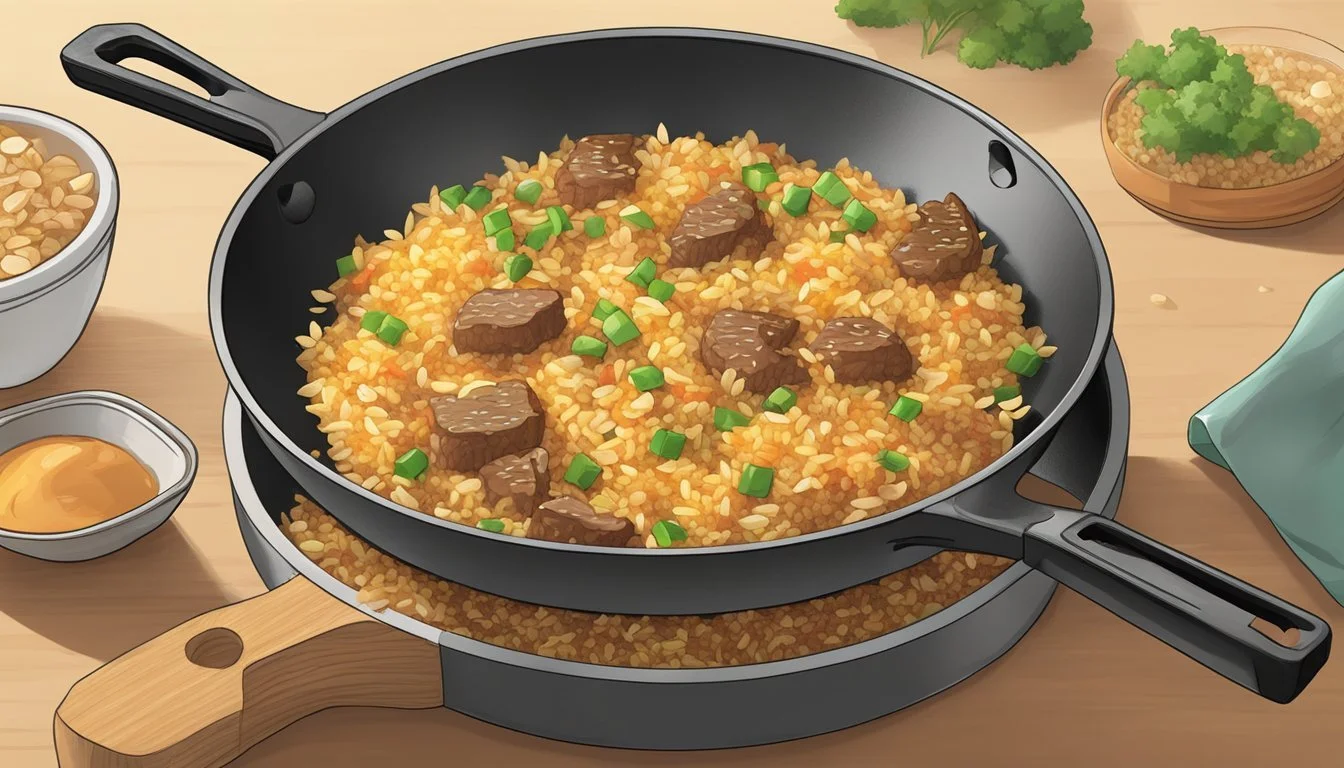How to Reheat Gluten-Free Beef Fried Rice for Best Flavor
Gluten-free beef fried rice is a delicious and satisfying dish that offers both convenience and flavor to those following a gluten-free diet. Properly reheating this dish ensures that it maintains its texture and taste without becoming dry or mushy.
To reheat gluten-free beef fried rice perfectly, use a skillet over medium-high heat with a dash of oil to keep it moist and flavorful. Adding a splash of water or broth can help rejuvenate the rice and prevent it from drying out. Stirring occasionally ensures even heating and prevents sticking.
For those with an air fryer, this method can help crisp up any bits of vegetables or beef in the fried rice. Simply place the rice in a heat-proof bowl, add some water or broth, and set the air fryer to 356°F (180°C) for 3 to 5 minutes, stirring halfway through.
Understanding Gluten-Free Ingredients
Choosing the right ingredients is crucial for anyone adhering to a gluten-free diet. This entails careful selection of rice, proteins, and seasonings to ensure the dish remains safe and enjoyable for those with gluten sensitivities.
Rice Selection for Gluten-Free Options
Rice is a staple in gluten-free diets due to its versatility and natural absence of gluten. White rice, brown rice, jasmine rice, and basmati rice are all excellent choices. These varieties can be cooked to a fluffy texture, providing a solid base for fried rice recipes. Long-grain rice is particularly favored for its non-sticky nature, which helps create a perfect texture for fried rice.
When choosing rice, it's important to check for any potential cross-contamination during processing. Certified gluten-free labels can provide assurance that the rice is safe for gluten-free cooking.
Safe Protein Choices
Incorporating protein into gluten-free fried rice can enhance its nutritional profile and flavor. Common gluten-free protein options include chicken, shrimp, tofu, eggs, pork, ham, and bacon. These proteins can be easily integrated into fried rice and provide a delicious source of vitamins and minerals.
Marinating proteins like chicken or steak using gluten-free soy sauce or tamari sauce can add flavor without risking gluten exposure. Tofu provides a vegetarian option that absorbs flavors well and is naturally gluten-free.
Selecting Gluten-Free Seasonings
Seasonings are essential in creating a flavorful dish, but it's vital to ensure they are gluten-free. Common seasonings for fried rice include soy sauce, tamari, coconut aminos, sesame oil, salt, and black pepper. Tamari sauce is a popular gluten-free alternative to traditional soy sauce, offering similar taste and texture.
Coconut aminos provide a slightly sweeter, lower-sodium option for those monitoring their intake. Care should be taken to avoid any seasonings with added wheat or barley, and always check labels for gluten-free certification to avoid cross-contamination.
Preparation of Ingredients
Before reheating gluten-free beef fried rice, it is crucial to ensure that the ingredients are prepared properly. This will enhance the flavor and texture of the dish and create a balanced combination of rice, vegetables, and protein.
Handling Rice for Optimal Texture
For the best results, use leftover rice that has been refrigerated for at least a few hours or overnight. Freshly cooked rice can be too moist, leading to a mushy texture. Leftover rice, by contrast, tends to be firmer and can develop a perfectly fluffy texture when reheated.
Break up any clumps of rice with a fork to ensure even heating. If using fresh rice, try spreading it on a baking sheet and allowing it to cool for at least 30 minutes. This helps reduce moisture content.
Chopping Vegetables for Even Cooking
Uniformly chopping vegetables is key to consistent cooking times. Carrots, peas, bell peppers, and onions are classic choices for fried rice. Dice carrots and bell peppers into small, even pieces about the size of peas to ensure they cook at the same rate.
Broccoli and cauliflower should be chopped into small florets. Green onions can be sliced thinly. Ensure that garlic is minced finely to avoid large, overpowering chunks. This attention to chopping ensures that all vegetables blend seamlessly in the dish and cook evenly.
Mixing Proteins and Other Add-ins
When incorporating proteins, start with cooked beef cut into bite-sized pieces. If the beef was initially seasoned, it should blend well with the rest of the ingredients. Scrambled eggs play a significant role in fried rice and should be cooked separately before being added to the rice.
To create a more complex flavor profile, add finely minced garlic to the mix. A small amount of sesame oil and gluten-free soy sauce can enhance the taste without overpowering the other elements. Additional add-ins like snow peas or cauliflower rice can introduce more texture and nutrient variety.
Cooking Techniques
When reheating gluten-free beef fried rice, specific techniques can revitalize your dish, preserving its flavors and textures. Key methods focus on proper heat application and ingredient handling to enhance taste and aroma.
Stir Fry Basics with a Skillet or Wok
Using a skillet or wok is ideal for reheating fried rice. Vegetable oil, avocado oil, or sesame oil are good choices due to their high smoke points.
Heat the skillet or wok on medium-high.
Add about 1 tablespoon of your chosen oil.
Spread the rice evenly in the pan.
Stir occasionally for about 4-5 minutes until thoroughly heated.
This method ensures even heating and brings back the initial stir-fried texture.
Sautéing Garlic and Onions for Fragrance
To elevate the aroma of your reheated rice, sauté garlic and onions before adding the rice.
Mince a garlic clove and half an onion.
Heat 1 tablespoon of olive oil or butter in the pan.
Sauté the garlic and onions until they are fragrant and slightly caramelized.
This step infuses the fried rice with rich flavors, making each bite more enjoyable.
Combination and Flavoring
Combining the reheated rice with additional seasonings such as soy sauce, salt, and pepper can enhance the dish.
After sautéing garlic and onions, add the rice.
Drizzle 1-2 teaspoons of soy sauce for umami flavor.
Season with salt and a pinch of pepper.
For additional depth, consider a splash of sesame oil. These steps help create a balanced, flavorful dish that retains the essence of freshly prepared fried rice.
Reheating Methods
There are several effective ways to reheat gluten-free beef fried rice to preserve its texture and flavor. Each method requires specific steps to ensure the rice remains moist and delicious.
Stovetop Reheating Procedure
Reheating on the stovetop is an excellent method for retaining the moisture and texture of leftover fried rice. Begin by adding a small amount of oil, water, or broth to a skillet over medium-high heat.
Once the liquid is warmed, add the fried rice, stirring continuously. This helps distribute the heat evenly. Cook for approximately 10 minutes or until the rice is thoroughly heated and any added liquid has evaporated.
Using a non-stick skillet ensures the rice doesn’t stick to the pan, making this method both efficient and effective.
Utilizing Microwaves for Quick Heating
Microwaving is a fast and convenient method for reheating gluten-free beef fried rice, although careful attention is required to avoid overcooking.
Place the rice in a microwave-safe container and drizzle with a few tablespoons of water or broth. This helps to maintain moisture.
Cover the container with a microwave-safe lid or plastic wrap to prevent splattering. Set the microwave to 50% power and heat for 2-3 minutes, stirring halfway through to ensure even heating. Check the rice’s texture and continue microwaving in short intervals if necessary.
Oven and Air Fryer Guidelines
For larger batches or to achieve a slightly crispy texture, reheating in the oven or air fryer is ideal. To use the oven, preheat to 350°F (175°C). Spread the rice evenly on a baking sheet, adding a light drizzle of water or broth. Cover with aluminum foil and bake for about 15-20 minutes, stirring once halfway through.
In the air fryer, place the rice in a heat-proof bowl within the fryer basket. Stir in a small amount of water or broth and set the air fryer to 356°F (180°C). Heat for 3-5 minutes, stirring halfway through for even heating. This method ensures a fluffy texture with slightly crispy edges.
Food Storage and Safety
Proper storage of gluten-free beef fried rice is essential to ensure it remains safe to eat. Follow these storage guidelines to maintain the quality and safety of your leftovers.
Proper Storage Techniques
Store leftover gluten-free beef fried rice in an airtight container to keep it fresh and prevent contamination. Place the container in the refrigerator promptly, ideally within two hours of cooking, to minimize bacterial growth. Ensure the rice cools to room temperature before sealing it to avoid condensation, which can lead to soggy rice and potential mold growth.
Label the container with the date when it was stored. Consume refrigerated fried rice within 3-4 days. Vegetables and meat in the fried rice can deteriorate faster, so always check for any off smells or discoloration before reheating.
Freezing and Thawing Fried Rice
Freezing gluten-free beef fried rice can extend its shelf life up to three months. Spread the rice in a single layer on a baking sheet to pre-freeze it for one hour. This step prevents the grains from clumping together. After pre-freezing, transfer the rice into a freezer-safe, airtight container or a resealable freezer bag.
Thawing should be done safely in the refrigerator. Transfer the frozen rice to the refrigerator the night before you plan to reheat it. Avoid thawing at room temperature as this can encourage bacterial growth. For a quicker thawing option, use the microwave’s defrost setting.
When reheating thawed rice, ensure it reaches an internal temperature of 165°F (74°C) to kill any potential bacteria. Stir frequently to distribute heat evenly, especially if using a microwave or stovetop method.
Serving and Presentation
To elevate your gluten-free beef fried rice, consider thoughtful garnishing and complementing it with suitable side dishes. These details not only enhance the appearance but also enrich the overall dining experience.
Garnishing Tips for Enhanced Appeal
Enhance the visual appeal with chopped green onions, which add a pop of color and a hint of freshness. Fresh cilantro can also be sprinkled on top for an additional layer of flavor and aesthetic appeal.
Sesame seeds are a classic choice; they not only look good but also add a subtle nutty flavor. For a bit of a kick, consider adding a few thin slices of fresh red chili on top to provide a spicy contrast and vibrant look.
Here is a summary of effective garnishes:
Garnish Benefit Chopped Green Onions Freshness and color Fresh Cilantro Herbaceous flavor and visual appeal Sesame Seeds Nutty flavor and textural contrast Red Chili Slices Spicy element and color pop
Side Dish Recommendations
Pairing the fried rice with the right side dish can elevate the meal. A light Asian vegetable stir-fry is an excellent complement, providing freshness and crunch without overwhelming the flavor of the rice.
For a classic touch, consider spring rolls or dumplings. These appetizers are universally loved and fit well with the theme of the meal. Another great option is miso soup which brings a warm, savory broth to the table, balancing the richness of the fried rice.
These side dishes add diversity to the meal and complete the dining experience:
Asian Vegetable Stir-Fry: Fresh and light.
Spring Rolls/Dumplings: Classic and universally appealing.
Miso Soup: Warm and savory balance.
This balanced approach to serving ensures that every bite is enjoyable and visually appealing, making your gluten-free beef fried rice a standout dish.
Adapting the Recipe
Adapting the recipe for reheating gluten-free beef fried rice involves making thoughtful substitutions for dietary needs and adding variety with different proteins. This ensures the dish remains versatile and suitable for various dietary preferences.
Making Substitutions for Dietary Needs
For those with additional dietary restrictions, several substitutions can be made while maintaining the flavor profile. Vegetarian options can easily swap out beef with tofu or extra vegetables, such as bell peppers and peas, to achieve a satisfying meal.
For people avoiding soy, replace soy sauce with coconut aminos. This gluten-free alternative keeps the umami flavor. Sesame oil can be omitted for those with allergies and substituted with olive or avocado oil.
Use oil-free or low-sodium products to adjust for other dietary concerns without sacrificing taste. Ensure all ingredients, including frozen vegetables, are labeled gluten-free to prevent cross-contamination. Customize the recipe to meet personal dietary requirements while enjoying the same delicious taste.
Adding Variety with Different Proteins
Incorporating different proteins offers new twists on the traditional gluten-free beef fried rice. Shrimp can provide a seafood variation, adding a tender, juicy element. Marinate shrimp with garlic and ginger before cooking to infuse more flavor.
For a more classic taste, chicken fried rice is a popular alternative. Diced chicken breast or thigh meat can be stir-fried until golden. Egg-fried rice is another simple addition, with scrambled eggs mixed into the dish providing extra protein and richness.
To keep meals exciting, alternate between different proteins such as beef, chicken, shrimp, or tofu. This not only improves variety but also caters to different dietary needs and preferences.
Advanced Tips
Enhancing the flavor and nutritional value of gluten-free beef fried rice can elevate your reheated dish, making it just as enjoyable as when freshly cooked.
Maximizing Flavor and Texture
To maintain the dish's deliciousness, heat it using a skillet instead of a microwave. Start by warming up 1-2 tablespoons of olive oil or coconut oil in the skillet over medium heat.
Add the leftover fried rice and stir constantly to avoid sticking. This method helps in achieving a crispy texture, bringing out flavors that microwaving might miss.
Additionally, mix in some fresh ingredients like diced green onions or a sprinkle of sesame seeds to give it a fresh, aromatic upgrade. Reheating it in portions rather than all at once ensures even heating and better texture.
Healthy Tweaks for Nutritional Benefits
Integrate more nutrients into your reheated dish by adding extra vegetables such as spinach, broccoli, or bell peppers. These veggies not only add vitamins but also enhance the texture with a pleasant crunch.
For a gluten-free soy sauce alternative, use coconut aminos. It has a similar flavor profile but contains less sodium and provides a slight hint of sweetness.
Include a dash of turmeric or ginger powder to your reheated rice for additional anti-inflammatory benefits. Lastly, use olive oil rather than butter to add healthy fats, which are essential for heart health.
Making thoughtful adjustments to the reheating process can both preserve and amplify the essence of your homemade gluten-free beef fried rice.







